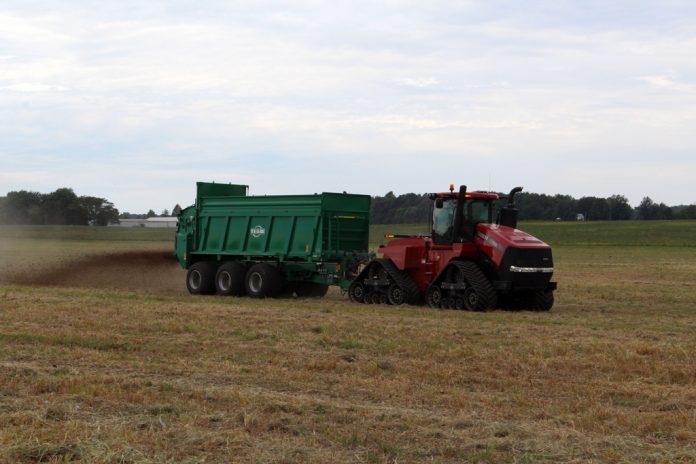Here are the numbers: a mature dairy cow weighing 1,400 pounds generates approximately 14 gallons (about 120 pounds, or 1.9 cubic feet) of manure each day.
Here is the issue: what do you do with all that manure, day in and day out?
A lot of dairy farmers view collecting, storing, transporting and spreading manure equivalent to taking out the trash. Nothing fun, nothing new, nothing exciting. It’s a chore like unloading groceries or getting new tags at the BMV. You do it as quickly as possible and wish it wouldn’t happen so often.
I would suggest a mind shift. Instead of seeing spreading manure like taking out the trash, think of it as recycling. Now, what once was a thankless task is a noble act of practicing and promoting sustainability, while closing the waste loop. It is a chore with an honorable purpose.
Properly applied, manure supplies organic matter to the soil. A higher percentage of organic matter improves soil tilth, helps with water and nutrient retention, reduces wind and water erosion and promotes growth of beneficial organisms.
Just like proper recycling, which means avoiding contaminating a load with dirty, greasy items, you must “take out the recycling” the right way by following three steps.
Spreading
The first step is knowing how much and where you are spreading. Avoid the tendency to spread only close to the barn because it’s convenient, and apply as evenly as possible. You don’t want one field to get too much, another field too little. It is best to take a whole farm approach to help replace the nutrient losses from harvesting.
To calculate how much solid or semi solid manure is spread using the tarp (weight-area) method, you need a 100 square feet tarp or heavy plastic, tent pegs or nails, scale and bucket. Follow these instructions:
Stuff the sheet in the bucket and use a scale to weigh it.
Lay the sheet in the field in the path of manure spreader, positioning it so the tractor will be at spreading speed before it reaches the sheet.
After spreading, weigh the sheet and manure in the bucket. Subtract the weight of the sheet and bucket.
Repeat this step three or four times to get an average weight.
To calculate the manure application rate use this formula: Weight of collected manure (in pounds) ÷ size of plastic sheet (in square feet). Then multiply your value by 21.8 to convert to tons per acre.
Knowing
The second step is knowing what is in your manure. Not all manure is created equally. Its nutrimental values are affected by method of storage, type of manure application, housing and bedding systems, feed and environmental conditions. You can use book values, but those are only ballpark averages. It’s like saying, to get to San Francisco, head west.
Manure tests are well worth the money, costing between $32 and $46. When you test liquid manure systems, make sure the pit is agitated vigorously before drawing samples so the top water and settled solids are blended. For solid manure systems, take several core samples through the manure.
Most soil and water conservation districts have lists of certified labs that perform manure analysis.
Once you have the test results and calculated volume spread, you are ready to determine how much of the nutrients are plant available. A good rule of thumb is 70-80% for potassium and 70-90% for phosphorus in the first year.
If manure is consistently applied year after year, then the full amount of phosphorus and potassium can be assumed to be available to the plants due to mineralization of previously applied nutrients.
Nitrogen is trickier
There are two forms of nitrogen in manure — organic and ammonium — with a small fraction of nitrate nitrogen and ammonia nitrogen. Mineralization will convert 33-50% of organic nitrogen to ammonium nitrogen, a soluble inorganic form plants can use, each year.
For example, in the first year a sample with 50% organic nitrogen would have a 25% (50 ÷ 2) nitrogen credit; in the second year it would have 12% (25 ÷ 2) credit; in the third year it would be 6% (12÷2).
Credit
The third and final step is to credit the manure to your fertilizer requirements by doing the following:
Determine how much fertilizer your crop requires per the Tri-State Fertilizer Recommendations for potassium and phosphorus and the Maximum Return to Nitrogen Model for nitrogen;
Subtract the available plant nutrients via your manure applications;
Subtract the available plant nutrients as stated in your soil tests;
Use the resulting numbers to place your fertilizer order.
As critical as the chemistry is in understanding the impact of manure on farm fields, it is more important to get the right frame of mind. So, when your partner says, “It’s time to take out manure,” correct him not with chemistry and formulas, but with the catchphrase, “it’s time to take out the recycling.” Mother Earth will thank you.













